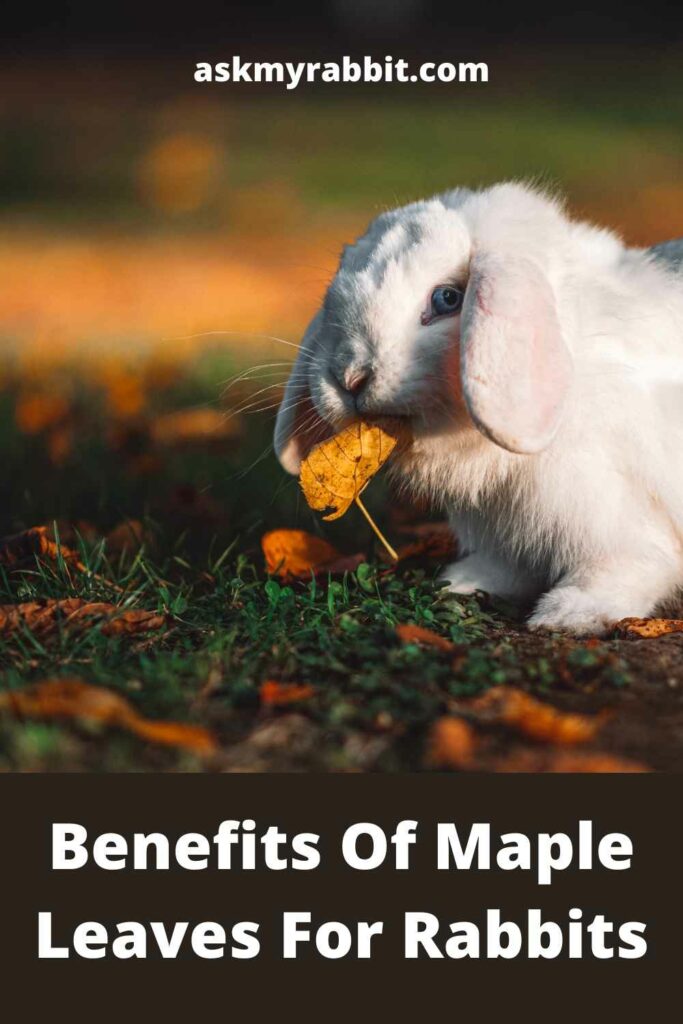Are you a new rabbit mom who’s wondering what and how to feed your rabbit?
Maple syrup will be a staple in everybody’s breakfast and have you ever thought of letting your fur baby take a nibble of the maple?
Are you confused about whether like other leaves, maple leaves are safe for rabbits? Let’s see…
Can rabbits eat maple leaves? Yes, rabbits can eat maple leaves. Maple leaves are bun-safe. It is also packed with key vitamins and nutrients that will help your bun’s growth.
In this article, we will discuss more about feeding maple leaves to your rabbit, the health benefits, and more about feeding maple leaves to rabbits.
Let us hop straight in!

Do Rabbits Eat Maple Leaves?

Maple leaves come from maple trees. Maple leaves are the leaves of maple trees, which are deciduous trees or shrubs belonging to the genus Acer. They can be found in many parts of the world and produce a sweet food called maple syrup.
All rabbit moms know that rabbits are fond of greens and veggies. Leaves and plants are a major part of their diet. So it’s common that you wonder if maple leaves can be a part of their diet.
Like with other types of leaves, it is safe to give your rabbit some maple tree leaves. Maple leaves are safe for consumption by your rabbits if given in moderation and make an excellent treatment option. You can feed your rabbit maple leaves either fresh or dried ones.
Rabbits don’t have the best digestive system and maple leaves will be a great option for them. Maple leaves are easy for your rabbits to digest. Maple leaves also provide a wide array of nutrients.
It is recommended not to feed your rabbit maple leaves if they are younger than 12 weeks. If your rabbit is nursing or pregnant, maple leaves are the best option for them because it is filled with potent nutrients suitable for them at the time.
We have more to discuss about the risks and benefits of feeding maple leaves to your furry baby. Let’s go over them!
Are Maple Leaves Toxic To Rabbits?
Nope! Maple leaves aren’t toxic or fatal to rabbits. Rabbits can consume maple leaves without having any life-threatening risks. Maple leaves are a common rabbit food and they can munch on it without worrying given that it’s given to them in moderation.
Maple leaves also provide a lot of health benefits for your rabbit such as high fiber content, high calcium, low calories and low-fat content, and more. Let’s jump into it!
Can Rabbits Eat Japanese Maple Leaves?
Japanese maple is a small deciduous tree or large shrub with a broadly spreading crown. The plant can be grown as a small single-stemmed tree or large multiple stemmed shrubs.
Leaves of the species form are oppositely arranged, hand-shaped, 2 to 5 inches long and have 5 or 7 lobes. Summer color is green and autumn color varies from orange to yellow to red to purple.
It is safe to say that rabbits can eat Japanese maple leaves but in moderation. Since the sugar content is slightly higher in Japanese maple leaves, you have to limit it.
Many pet owners say that their furry babies eat Japanese maple leaves with no problems if the diet is balanced out by fresh hay and other veggies.
Japanese maple leaves are not fatal or toxic for rabbits but keep in mind you give them the leaves in moderation.
Benefits Of Maple Leaves For Rabbits

By now, you know that maple leaves are safe for rabbits to eat. Let’s discuss why you should feed maple leaves to your rabbit and the benefits of it.
- Vitamin C: maple leaves are rich in vitamin C. Vitamin C is required for the development of strong bones and connective tissue.
- Immunity: maple leaves can boost immunity. It can aid in the prevention of infections from bacteria or parasites. It will make your furry friends Immune from diseases also.
- Vitamin A: it is a great source of vitamin A which helps with growth, healthy hair coats, and skin and reproductive functions.
- Antioxidants: it is a good source of antioxidants. It can help prevent cancer and other diseases in rabbits.
- Low in calories and fat: the low calories and fat level in maple leaves make them a healthy option for your rabbits.
- Fiber: maple leaves are a great source of fiber. This will aid in the digestion process.
- Calcium: maple leaves are high in calcium. This will help their teeth and bones stay strong.
- Constipation and Diarrhea: maple leaves can help rabbits from constipation and diarrhea. It can be used to treat rabbits who have an upset stomach or digestive problems.
- Obesity: since maple leaves are a healthy option, it will cut down the risk of your rabbit getting obese.
Even though it is a healthy snack, you have to give it in moderation. After giving maple leaves you have to provide hay afterward to keep it balanced.
Risks Of Feeding Maple Leaves To Your Rabbits

With pros come cons as well. If your rabbits consume maple leaves more than the recommended amount or more than moderation, it can cause a few riffs for your bun. Let’s see what they are.
- Obesity: if consumed more than the required amount, your rabbit is at the risk of getting obese. The sugar in the maple leaves can cause obesity in rabbits.
- Can cause anemia: If fed excessively over long periods, a bunny can develop iron deficiency.
- Tooth decay: since the maple leaves require excessive chewing before swallowing, consuming more than moderation can cause the teeth of rabbits to wear down. The sugar content causes tooth decay if eaten daily for a long time.
- Decrease in appetite: if eaten in excess, it can cause a decrease in the appetite of your rabbit. It can lead to a decreased interest in hay and grass, which is necessary for the proper digestion of food.
- Diarrhea: if eaten in excess, maple leaves can cause diarrhea in rabbits.
These are the few reasons why you should not overfeed maple leaves for your rabbits. Always remember to stick to the recommended amount depending on your bun’s age and weight.
How To Stop Rabbit From Eating Maple Leaves?
Is your rabbit giving you a hard time by eating only maple leaves? Every time you let them roam around, are they going back to the maple tree? Don’t worry, we will discuss a few ways to keep your rabbit from eating too many maple leaves.
You shouldn’t let them roam around without supervision. If you find them eating more than the required amount of leaves then you have to remove them from the place.
If your rabbits are consuming maple leaves from around the tree, you can use a rabbit repellent that is bun-safe on the surrounding of the tree and the bark. This will keep your bunny away from the side.
You have to feed your rabbit fresh hay and lots of water after they eat maple leaves to keep their diet balanced.
You can also put up barbed wires or mesh around the tree or the maple grounds where your rabbits are likely to go.
Frequently Asked Questions
How many vegetables should a rabbit eat daily?
No more than two cups daily of fresh vegetables should be given to adult rabbits. Dwarf breeds and rabbits under five pounds should get just one cup of fresh veggies per day. A variety of two or three vegetables is ideal.
How much fresh vegetables should I feed my rabbit?
No more than two cups daily of fresh vegetables should be given to adult rabbits. Dwarf breeds and rabbits under five pounds should get just one cup of fresh veggies per day. A variety of two or three vegetables is ideal.
Final Word
Now we know the answer to the question: Can rabbits eat maple leaves? Yes, they can and in fact, it is highly nutritious and beneficial for their health.
Even though it is nutritious, it is recommended to feed them maple leaves in moderation because of the above-listed health risks. You should always stick to the recommended amount depending on your bunny’s age and weight.
I hope this article cleared all your queries about feeding maple leaves to your rabbit. If you have queries regarding the topic, comment down below. For more rabbit articles, stay tuned to our blog!






